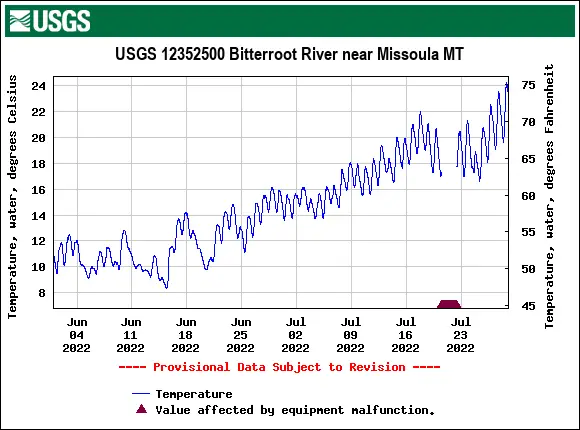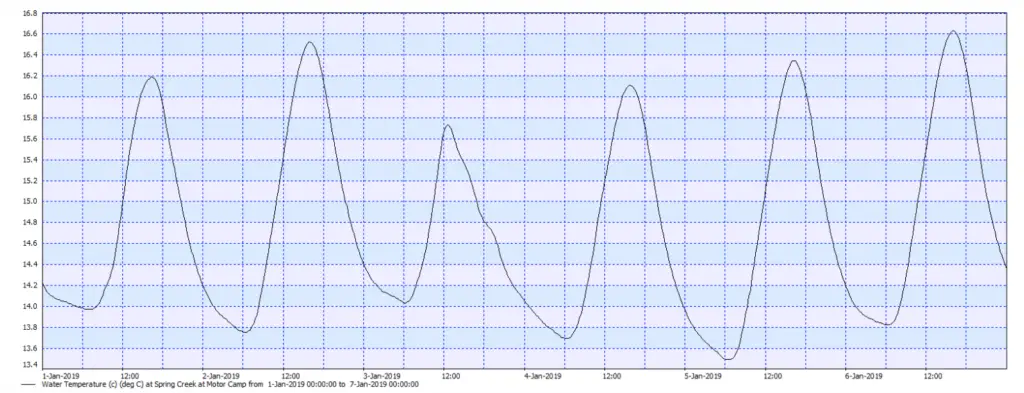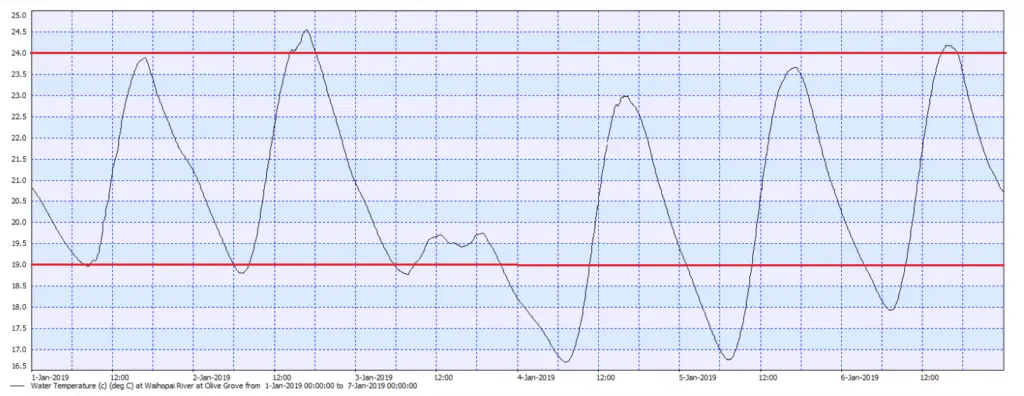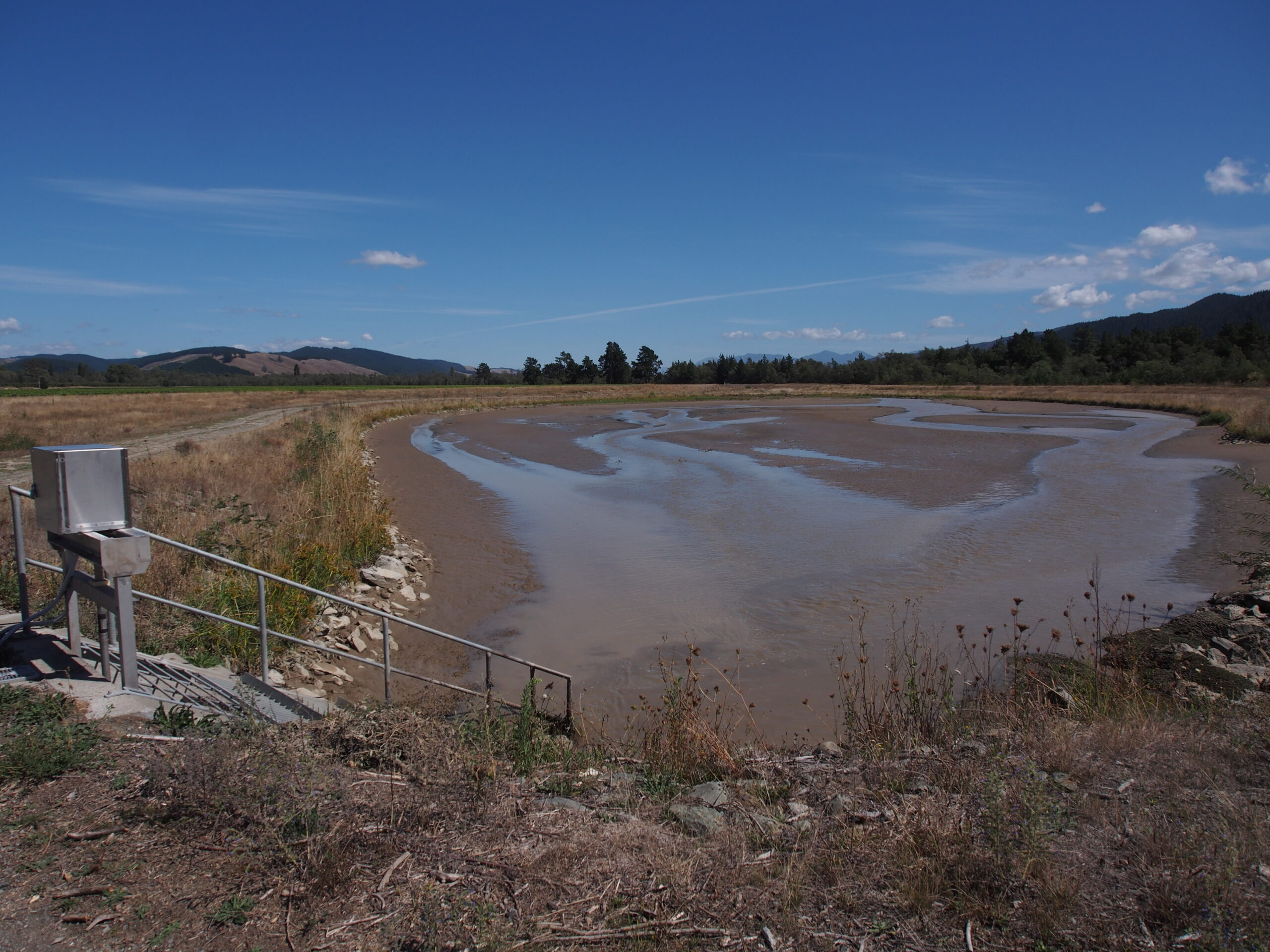Another summer, another heatwave is hitting the Pacific Northwest. Temperatures over 110 are being predicted for the interiors of Oregon and Washington states. Globally this is not an isolated occurrence, with newsworthy heatwaves hitting northern Europe earlier in the summer.
I am not going to discuss the heatwaves in general. But I want to cover how hot weather affects trout fishing. I also will provide some great places to find quality trout fishing even in the hottest of weather.
Firstly, trout need cold water.
When water temperatures get too high, trout struggle to get enough oxygen. If temperatures remain elevated for too long, they die. Put simply, higher temperatures, warmer water, and fewer trout. It was estimated that the recent heatwave in the United Kingdom killed tens of thousands of fish. The same stories repeat wherever heatwaves occur.
This chart below shows the temperature preferences of different species of trout. It can be a good idea to take a thermometer to the river with you to quickly know the temperature. Alternatively, the temperature for many trout rivers is published online. This website by USGS is a great place to start, and I am certain similar resources exist for other countries.
| Optimal Feeding temperature | Temperature trout become stressed | Lethal temperature |
| Brook trout | 44-64f (6-18c) | 65f (18c) | 70f (21c) |
| Cutthroat trout | 39-59f (4-15c) | 60f (15.5c) | 68f (20c) |
| Rainbow trout | 44-67f (6-19c) | 68f (20c) | 75f (24c) |
| Brown trout | 44-67f (6-19c) | 68f (20c) | 75f (24c) |
| Lake trout | 40-59f (4-15c) | 65f (18c) | |
Avoid catch and release fishing when water temperatures are high.
Hot summer days are not a good time for catch and release fishing because the survival rate is significantly lower than normal conditions.
This is a simple one when water temperatures are high (see the previous chart), trout are already under stress. A prolonged fight for survival against fishermen is often enough to knock them over the edge. Either fish to keep or chase a different species.
This is how I like to think about it, imagine being forced to sprint a mile in 100 degree heat. I suspect most of us will be exhausted after that. But, that is not all. After the sprint, while still panting for air you are forced to hold your breath for a minute. It all becomes too much, and many trout do not survive.
If you still plan on going trout fishing in warm water conditions. Finish the fights as quickly as possible and leave the trout in the water at all times and expect almost any bleeding to be fatal.
Not enough water
In most catchments, hot weather results in a reduction in the flow of rivers, this is because hotter temperatures speed up evaporation and streams start to dry. This is compounded by the fact that heat waves are usually associated with high atmospheric pressures that further depresses spring flows.
To add to the water woes, the demand for water usually increases during periods of hot weather. Farmers want to use more to save their livelihoods, residential areas use more to keep cool. So, there is less water, but more demand for it. This causes water levels to drop even faster.
In general, hot weather speeds up evaporation, reducing the flows of many freestone rivers. This in turn raises temperatures.
This chart below, courtesy of the UGSG shows this summer’s water temperature of a Montana freestone river. Notice the sharp increase in water temperature that coincides with the start of the recent heatwave.

Too much water.
There is one exception, hot weather can increase flows. High temperatures can cause rapid melting of high elevation snow packs and glaciers which can cause significant floods in rivers which are fed by them. These will become increasingly rarer as the permanent snowpacks continue to melt and the glaciers retreat.
For example, due to a recent heatwave, I just read that the Greenland icesheet lost 6 billion tons of water for three days in a row. That is a big number that I struggle to comprehend. In other words, Greenland is losing a volume of water equal to a full Lake Mead every 5 days. Unsure just what impact that will have on the Arctic Char and Atlantic salmon populations.
Is too much water bad for trout? Will, it is better than too little water. But trout do best in stable flows. Violent floods can injure trout and wipe away the aquatic insects that trout feed upon.
Increased fire risks
Hot weather result in wildfires, and wildfires spread faster during heatwaves.
Out of control wildfires cause obvious damage to forests and the animals that live in them. But how about the river life?
First some good use, the water usually protects the fish and aquatic life from the initial heat of the fire. So they might survive the initial burn.
The bad news is that the first heavy rains wash all that ash, mud, and muck into the streams. There the ash can block the gills of fish and smother aquatic life. The ash runoff after a fire can be devastating for trout. For example, the ash runoff from the 2019 Dollar Ridge fire killed all the brown trout in the Wild Strawberry stream.
Impact on trout fishing
I do not want to discuss broader impacts for too long and want to concentrate on how it affects us the fishermen in the short term. What can we do to help the trout, and can we still go trout fishing in such heat?
My personal opinion. Stay home until the heat subsides. Getting melted in high temperatures is not enjoyable and the trout have their best chance to survive if left alone.
- Temperature Stress: Trout are cold-water fish, and excessively high water temperatures can cause stress and reduce their activity levels. As water temperatures rise beyond their preferred range (typically 50-65°F or 10-18°C), trout become less active, seek out cooler and deeper areas, and are less likely to feed.
- Low Oxygen Levels: Warmer water holds less dissolved oxygen, which is essential for fish survival. In hot weather, water can become oxygen-depleted, making it harder for trout to breathe and affecting their vitality.
- Altered Feeding Patterns: Hot weather can disrupt the feeding patterns of trout. They may become less willing to chase after flies or lures due to reduced energy levels caused by warmer water.
- Nocturnal Feeding: During heatwaves, trout might become more active during the cooler hours of early morning and late evening. Nocturnal feeding can offer anglers better chances of success.
- Increased Predation Risk: Elevated water temperatures can make trout more susceptible to predators, as their reduced speed and weakened state make them easier targets.
- Holding in Cooler Water: Trout will often seek out areas with cooler water, such as springs, tributaries, and tailwaters of dams, to find refuge from the heat. Anglers can focus their efforts in these areas.
- Catch and Release Concerns: Catching and releasing trout in hot weather can increase their stress levels and mortality rates due to the added stress of warm water conditions.
- Insect Activity: Hot weather can influence insect hatches, impacting the availability of natural food sources for trout. Anglers may need to adjust their fly choices to match the altered insect activity.
- Fishery Closures: In extreme cases, fishery management agencies might impose temporary closures to protect stressed fish populations from additional stress during heatwaves.
Where To Trout Fish During Hot Weather?
Other than flying to the southern hemisphere, for some winter fishing. There are a few options that remain viable for trout fishing even in hot weather.
High mountain lakes and streams
Higher elevations, such as mountain lakes are excellent options to fish in hot weather with water temperatures typically 10 to 20 degrees Fahrenheit (5.5 to 11 degrees Celsius) cooler than their lower elevation counterparts. The higher above sea level the cooler it becomes. This is why some mountain lakes still have ice even in June.
So, mountain lakes are a good way to escape the heat and catch some trout on even the hottest days.
Spring creeks are a consistent temperature year-round.
The next option is to fish spring creeks. Spring creeks get their water from aquifers that are nearly always cold. This means spring creeks can be a lot cooler than freestone rivers even in the same areas.
Spring creeks typically maintain temperatures several degrees cooler than freestone rivers. Spring creeks, sourced from underground springs, often have temperatures ranging from the mid-40s to low 50s Fahrenheit (7-12°C), while freestone rivers relying on surface runoff can reach the mid-50s to 60s Fahrenheit (12-20°C) or higher.
This temperature difference of around 10 degrees Fahrenheit (5.5 degrees Celsius) on average makes spring creeks appealing to cold-water fish like trout, providing a consistently cooler habitat even during hot periods.
While the water temperature in spring creeks might be cool. The air surrounding them can be hot and humid. Bring water, and dress appropriately for the temperatures. Wearing waders in such temperatures is just asking for heatstroke.


Tailwaters – surprisingly cool weather even in hot climates
Tailwaters, the sections of rivers downstream from dams or reservoirs, can remain fishable even during periods of hot weather. Tailwaters are often 10 to 20 degrees Fahrenheit (5.5 to 11 degrees Celsius) cooler than those in freestone rivers.
Water released from the reservoir’s depths typically hovers around 50°F (10°C), a stark contrast to the warmer surface waters experienced in freestone rivers during the late summer.
Tailwaters operate as thermal havens, providing trout with a constant and cool habitat that proves indispensable for their survival amid the extremities of heatwaves. This affect can be so great that worthwhile trout fisheries have been established in areas generally considered to be too warm for trout fishing, such as the Center Hill Dam tailwater in Tennesse or the San Juan River downstream of the Navajo Dam in New Mexico.
What to do with trapped trout in drying rivers?
I quite often come across trout trapped in isolated pools as their river dries. If you come across such fish it is a good idea to inform your local fisheries department.
Sometimes they have resources that allow them to capture and relocate fish caught in drying rivers. I have also assisted in a few relocations myself. It is a very good feeling saving wild fish from nearly certain death.


So does the clear cutting and resorts. Clear cutting leads to errossion, lack of water retention. Then the mess left behind in pipes leads to fuel and drier area’s for fires to break out. Then if that isn’t enough in my area the water is almost given away to bottling companies to export and sell for huge profit.
Good points.
In my area, clear cutting, followed by a winter downpour resulted in several feet of mud and branches burying several of my local spawning streams. It is so destructive.
30 years ago, those streams were amazing little fisheries. Now they are not worth the effort.